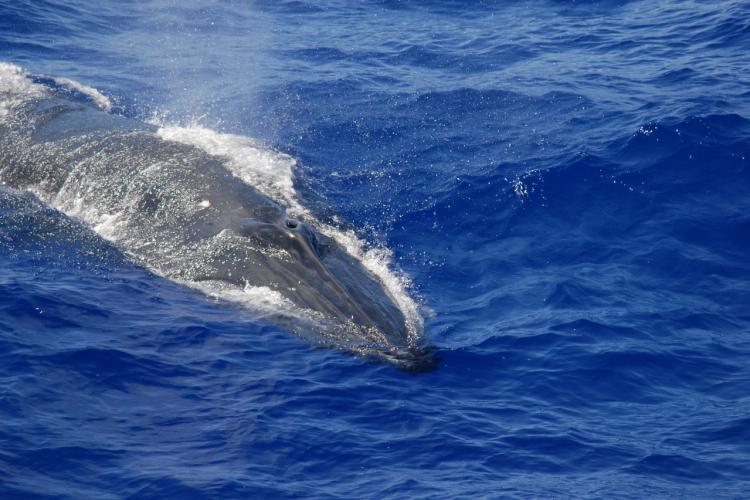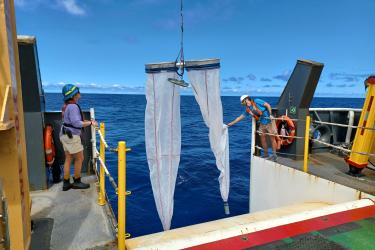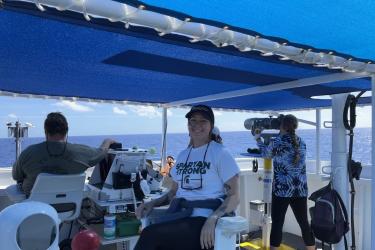Hafa Adai!*
The 2018 Mariana Archipelago Cetacean Survey (MACS) will focus on the deployment and recovery of Drifting Acoustic Spar Buoy Recorders. DASBRs collect passive acoustic data so we can estimate density and abundance of beaked whales and other cetaceans. The science team will also conduct visual surveys—including group size estimates, photo-identification, biopsy samples, and satellite tags—and tow a hydrophone array to hear cetaceans while we traverse along a systematic survey grid.
*Hafa Adai (pronounced "half a day") means "hello" in Guam's native Chamorro language.

Schematic of the Drifting Acoustic Spar Buoy Recorder (DASBR).
Prepping the HARPs

In addition to drifting recorders, we use High-Frequency Acoustic Recording Packages (HARPs) offshore of Saipan and Tininan to listen for whales and dolphins over an extended period of time. Each year, we collect the recordings from the HARPs in this area and then redeploy them to continue recording for the next year. HARPs record a very broad frequency range, so we can hear of all vocal species in the area. (Photo: NOAA Fisheries/Suzanne Yin)
Sette at Farallon de Medinilla

The NOAA Ship Oscar Elton Sette off the coast of Farallon de Medinilla, as seen from a small boat. NOAA's Cetacean Research Program has been trying for years to survey cetaceans in the nearshore waters of the island, but has been prevented by nearby military training activities. This year, we were given permission to survey the area for two days. (Photo: NOAA Fisheries/Adam Ü)
Survey from a small boat

Farallon de Medinilla is a very small island. Within about an hour, we surveyed the nearshore areas surrounding the entire island and out to a small shoal. From the ship, we continued to survey further offshore and saw spinner dolphins, spotted dolphins, and short-finned pilot whales. (Photo: NOAA Fisheries/Marie Hill)
Short-finned pilot whales at Anatahan

The pilot whale is a high priority species for this research mission. We have a large collection of photo-identifications from the southern part of the Archipelago but none from more northern islands. These pilot whales were seen midway up the island chain, and may help us understand the population's movements. (Photo: NOAA Fisheries/Marie Hill)
HARP equipment and deployment

The acoustics team is deploying a recording package (HARP) near Pagan Island, where we've only ever deployed one HARP in the past. It will sit on the ocean bottom listening for whales and dolphins for two years before it is picked up again. This way, we don't need to physically survey the region to learn which cetaceans are present over a period of two years. (Photo: NOAA Fisheries/Ann Allen)
Taking a breath

So far, we have seen two Bryde's whales! We collected photos to confirm the species, and recordings from sonobuoys to identify their vocalizations. Bryde's whales (pronounced "bru-tes") are one of the few baleen whales expected to occur in tropical waters during summer months. (Photo: NOAA Fisheries/Adam Ü)
Small boat operations

We launched the small boat to collect images and samples of a group of short-finned pilot whales encountered 23 km (13 nmi) offshore of Anatahan. (Photo: NOAA Fisheries/Adam Ü)
HARP recovery

The scientific team recovered two additional recording packages (HARPs) from the ocean bottom. One was near the island of Tinian and the other near the island of Saipan. Both were on the seafloor recording whale and dolphin sounds for over a year. (Photos: NOAA Fisheries/Ann Allen)
DASBR deployment

The acoustics team deployed seven Drifting Acoustic Spar Buoy Recorders (DASBRs) along the west side of the Mariana Archipelago. The buoys have an audio recorder and two hydrophones and satellite tracking system. They will record sounds from whales and dolphins they encounter while drifting with the ocean currents for several weeks, until we pick them up to collect the recordings. (Photos: NOAA Fisheries/Yvonne Barkley)
Prepping for biopsy sampling

Three Bryde's whales approached our ship during an encounter. Our survey team managed to collected biopsy samples from two of the three individuals. (Photo: NOAA Fisheries/Eden Zang)
Leaping striped dolphins

This is a new species for us in the Marianas! We have been surveying the Marianas since 2010, and this is the first time we have seen striped dolphins here. (Photo: NOAA Fisheries/Adam Ü)
First DASBR recovery

The scientists recovered the first drifting acoustic spar buoy recorder (DASBR) they deployed. It recorded 12 days of acoustic data while drifting from the island of Guam to the West Mariana Ridge. (Photo: NOAA Fisheries/Adam Ü)
Rough-toothed dolphins

Our first rough-toothed dolphin encounter during this survey! These dolphins were seen at the southern end of the West Mariana Ridge. (Photo: NOAA Fisheries/Andrea Bendlin)
Melon-headed whales ride the surf

Melon-headed whales are typically in groups of hundreds, making it difficult to photo-identify them. At least one of the individuals seen during this encounter was also seen in 2015, approximately 175 nmi east of this location, near Sarigan Island. (Photo: NOAA Fisheries/Adam Ü)
Weekly safety drills

We conduct safety drills weekly at sea to ensure that all personnel are prepared in the event of an emergency. In this case, scientists and crew don life jackets and hold their survival suits as part of the drill to abandon ship. (Photo:NOAA Fisheries/Andrea Bendlin)
Deploying the array

Our team enjoys the conversation as we tow a passive acoustic hydrophone array to monitor marine mammal sounds in real time 300 meters behind the ship. It collects bearing angles to detected cetacean vocalizations, helping the visual team find whales and dolphins. (Photo: NOAA Fisheries/Ann Allen)
Repairing the array

Towing an oil filled array behind a ship at 10 knots can be hard on the equipment! We keep a constant watch on the cable and sensors and repair them as often as needed. (Photo: NOAA Fisheries/Ann Allen)
That's a wrap!

The activity in the final days of a cetacean cruise is a bit of a whirlwind--break down equipment, pack up equipment and personal gear, clean staterooms and community spaces--all while enjoying time with dear friends until the next project reunites us. (Photo: NOAA Fisheries)
––––––––––
All photos taken under NMFS research permits.
Partial funding for this survey was provided by the U.S. Navy, Pacific Fleet Environmental Readiness Office as part of a long term marine species research partnership with NOAA in the Mariana Islands.



